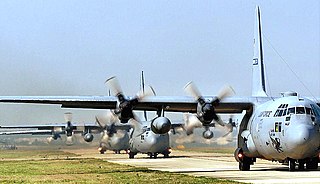
The Third Air Force (Air Forces Europe) (3 AF) is a numbered air force of the United States Air Forces in Europe - Air Forces Africa (USAFE-AFAFRICA). Its headquarters is Ramstein Air Base, Germany. It is responsible for all U.S. air forces in Europe and Africa, and operations and support activities in the U.S. European Command and U.S. Africa Command's areas of responsibility. It also has a unique mission as the U.S. military's primary liaison to the British government, which is conducted through the command's 3 AF-UK headquarters at RAF Mildenhall, England.

The 116th Air Control Wing is a Wing of the Georgia Air National Guard/United States Air Force, stationed at Robins Air Force Base, Georgia. If activated for federal service, the wing is gained by Air Combat Command.

Royal Air Force Bentwaters or more simply RAF Bentwaters, now known as Bentwaters Parks, is a former Royal Air Force station about 80 miles (130 km) northeast of London and 10 miles (16 km) east-northeast of Ipswich, near Woodbridge, Suffolk in England. Its name was taken from two cottages that had stood on the site of the main runway during its construction in 1943.

The 93d Air Ground Operations Wing is a United States Air Force unit assigned to Air Combat Command, Ninth Air Force. It is stationed as a tenant unit at Moody Air Force Base, Georgia.

The 92d Operations Group is the flying component of the 92d Air Refueling Wing, assigned to the United States Air Force Air Mobility Command Eighteenth Air Force. The group is stationed at Fairchild Air Force Base, Washington.

The 81st Training Wing is a wing of the United States Air Force and the host wing at Keesler Air Force Base, Mississippi. The 81st Training Wing has the Air Force's largest Technical Training Group and trains more than 40,000 students annually. Training includes weather, basic electronics, communications electronic systems, communications computer systems, air traffic control, airfield management, command post, air weapons control, precision measurement, education and training, financial management and comptroller, information management, manpower and personnel, radar, ground radio, and network control.

The 158th Airlift Squadron is a unit of the Georgia Air National Guard's 165th Airlift Wing located at Savannah Air National Guard Base, Georgia. The 158th is equipped with the C-130J Super Hercules and is operationally-gained by the Air Mobility Command (AMC).

The 188th Rescue Squadron is unit of the New Mexico Air National Guard. It is assigned to the 150th Special Operations Wing located at Kirtland Air Force Base, New Mexico.

The 116th Air Refueling Squadron is a unit of the Washington Air National Guard 141st Air Refueling Wing located at Fairchild Air Force Base, Spokane, Washington. The 116th was equipped with variants of the Boeing KC-135 Stratotanker from 1976 until 2007, at which time these aircraft were re-assigned to other units as a result of BRAC 2005.

The 61st Fighter Squadron is an active United States Air Force unit, assigned to the 56th Operations Group, at Luke Air Force Base, Arizona. It operates the F-35 Lightning II aircraft, conducting Pilot training.

The 159th Fighter Squadron is a unit of the Florida Air National Guard's 125th Fighter Wing located at Jacksonville Air National Guard Base at Jacksonville International Airport, Florida. The 159th is currently equipped with the F-15C and F-15D Eagle and is slated to transition to the F-35A Lightning II in 2024.

The 128th Airborne Command and Control Squadron is a unit of the Georgia Air National Guard 116th Air Control Wing located at Robins Air Force Base, Georgia. The 128th is equipped with the E-8C Joint STARS.

The 78th Attack Squadron is an Air Force Reserve Command (AFRC) unit under the 926th Wing, Nellis Air Force Base, Nevada and Tenth Air Force at Naval Air Station Joint Reserve Base Fort Worth, Texas. The 78 ATKS conducts operations from Creech Air Force Base, Nevada in conjunction with their active-duty associates in the 432d Wing.

The 93rd Fighter-Interceptor Squadron is an inactive United States Air Force unit. Its last assignment was with the Albuquerque Air Defense Sector at Kirtland Air Force Base, New Mexico, where it was inactivated on 8 July 1960.

The 92d Cyberspace Operations Squadron is a United States Air Force unit.

The 91st Attack Squadron is a United States Air Force Reserve unit based at Creech Air Force Base, Nevada, where it is an associate unit of the 432nd Wing operating General Atomics MQ-9 Reaper and RQ-170 Sentinel unmanned aerial vehicles (UAVs).

The 52d Operations Group is the flying component of the 52d Fighter Wing, assigned to the United States Air Forces in Europe - Air Forces Africa (USAFE-AFAFRICA). The group is stationed at Spangdahlem Air Base, Germany.

The 20th Operations Group is the flying component of the 20th Fighter Wing, assigned to the United States Air Force Air Combat Command. It is stationed at Shaw Air Force Base, South Carolina. It is a successor organization of the 20th Pursuit Group, one of the 15 original combat air groups formed by the U.S. Army before World War II.

The 93d Operations Group is an inactive United States Air Force unit. Its last assignment was with the 93d Air Control Wing, stationed at Robins Air Force Base, Georgia. The unit was inactivated on 1 October 2002.

The 116th Operations Group is a Georgia Air National Guard unit assigned to the 116th Air Control Wing. The unit is stationed at Robins Air Force Base, Georgia. The 116th Group controls all operational Northrop Grumman E-8C Joint STARS aircraft of the 116th Air Control Wing. It was activated in 1992, when the Air Force implemented the Objective Wing organization, and was successively equipped with the McDonnell Douglas F-15 Eagle and the Rockwell B-1 Lancer before converting to the E-8C in 2002.






























